ACX702 Applied Research Methods: Case Study of Industry Problem
VerifiedAdded on 2023/01/23
|20
|6382
|83
Report
AI Summary
This assignment presents a comprehensive case study addressing the industry problem of engaging millennial news consumers. The report begins with a literature review, analyzing three scholarly articles that explore communication research trends, the dislocation of news journalism due to online platforms, and the adaptation of news broadcasters to participatory journalism. The literature review informs the development of a research proposal, which includes a summary of the problem, the composition of Australian millennials, their trust in news, aims, and rationale for the study. The proposal outlines research questions, methodology, including a theoretical construct of cognitive dissonance, gap analysis, hierarchy of importance, instrument, schedule, budget, and ethical considerations. The study aims to understand the news consumption preferences of millennials, how to effectively engage them, and how news providers can adapt to this changing landscape. The report provides a detailed analysis of each component, offering insights into the challenges and opportunities within the news media industry.
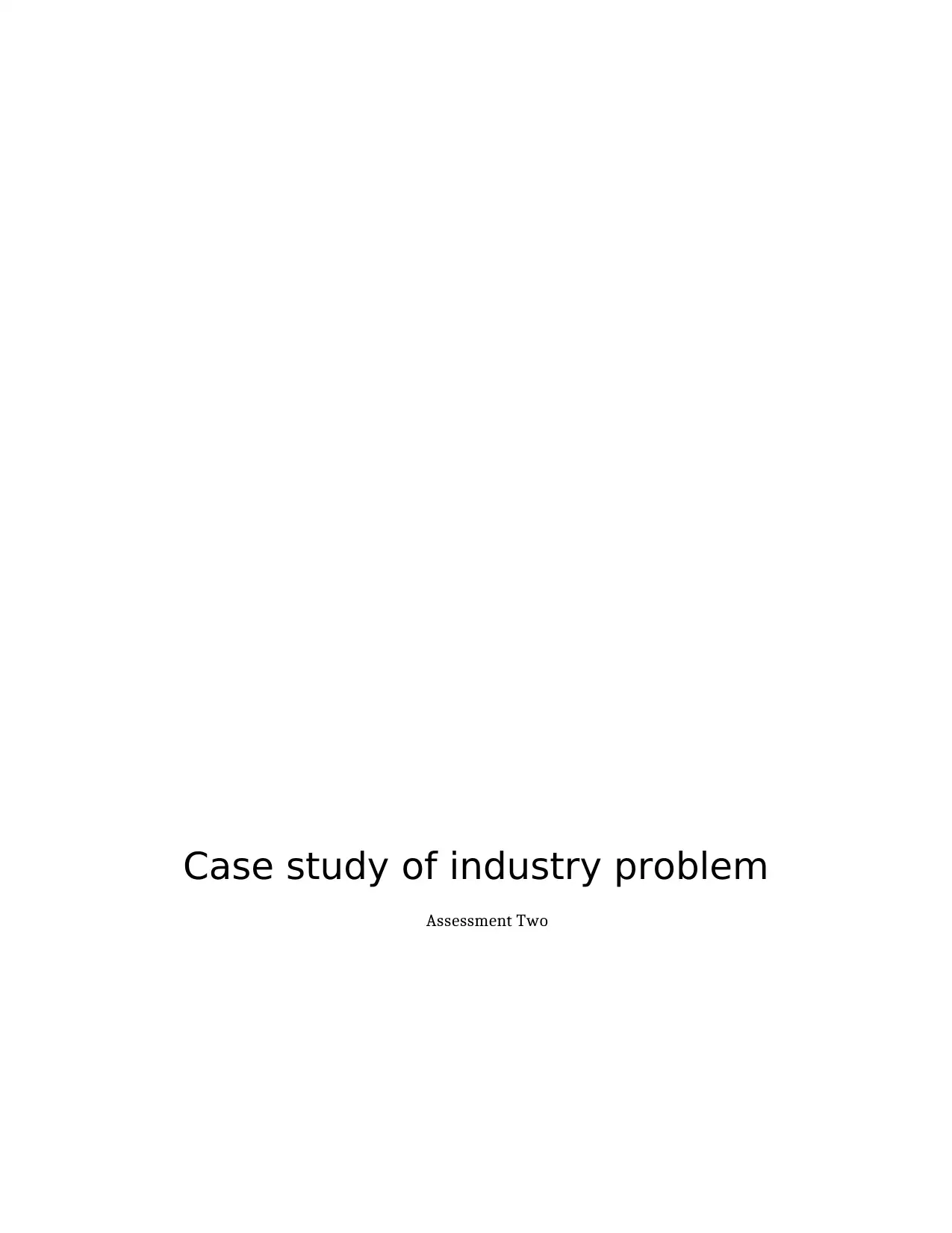
Case study of industry problem
Assessment Two
Assessment Two
Paraphrase This Document
Need a fresh take? Get an instant paraphrase of this document with our AI Paraphraser
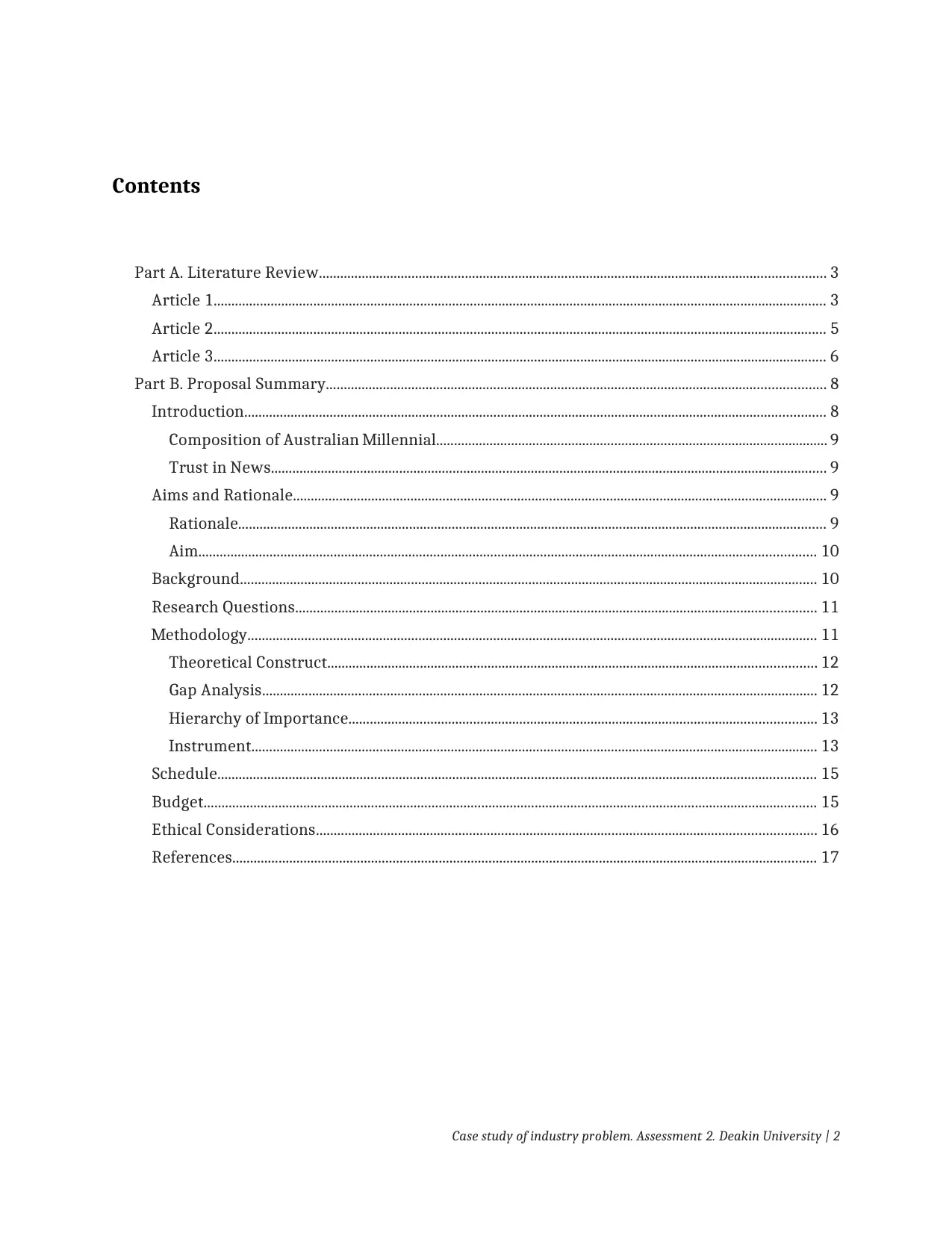
Contents
Part A. Literature Review.............................................................................................................................................. 3
Article 1............................................................................................................................................................................ 3
Article 2............................................................................................................................................................................ 5
Article 3............................................................................................................................................................................ 6
Part B. Proposal Summary............................................................................................................................................ 8
Introduction................................................................................................................................................................... 8
Composition of Australian Millennial.............................................................................................................. 9
Trust in News............................................................................................................................................................ 9
Aims and Rationale...................................................................................................................................................... 9
Rationale..................................................................................................................................................................... 9
Aim............................................................................................................................................................................. 10
Background.................................................................................................................................................................. 10
Research Questions.................................................................................................................................................. 11
Methodology................................................................................................................................................................ 11
Theoretical Construct......................................................................................................................................... 12
Gap Analysis............................................................................................................................................................ 12
Hierarchy of Importance................................................................................................................................... 13
Instrument............................................................................................................................................................... 13
Schedule........................................................................................................................................................................ 15
Budget............................................................................................................................................................................ 15
Ethical Considerations............................................................................................................................................ 16
References.................................................................................................................................................................... 17
Case study of industry problem. Assessment 2. Deakin University | 2
Part A. Literature Review.............................................................................................................................................. 3
Article 1............................................................................................................................................................................ 3
Article 2............................................................................................................................................................................ 5
Article 3............................................................................................................................................................................ 6
Part B. Proposal Summary............................................................................................................................................ 8
Introduction................................................................................................................................................................... 8
Composition of Australian Millennial.............................................................................................................. 9
Trust in News............................................................................................................................................................ 9
Aims and Rationale...................................................................................................................................................... 9
Rationale..................................................................................................................................................................... 9
Aim............................................................................................................................................................................. 10
Background.................................................................................................................................................................. 10
Research Questions.................................................................................................................................................. 11
Methodology................................................................................................................................................................ 11
Theoretical Construct......................................................................................................................................... 12
Gap Analysis............................................................................................................................................................ 12
Hierarchy of Importance................................................................................................................................... 13
Instrument............................................................................................................................................................... 13
Schedule........................................................................................................................................................................ 15
Budget............................................................................................................................................................................ 15
Ethical Considerations............................................................................................................................................ 16
References.................................................................................................................................................................... 17
Case study of industry problem. Assessment 2. Deakin University | 2
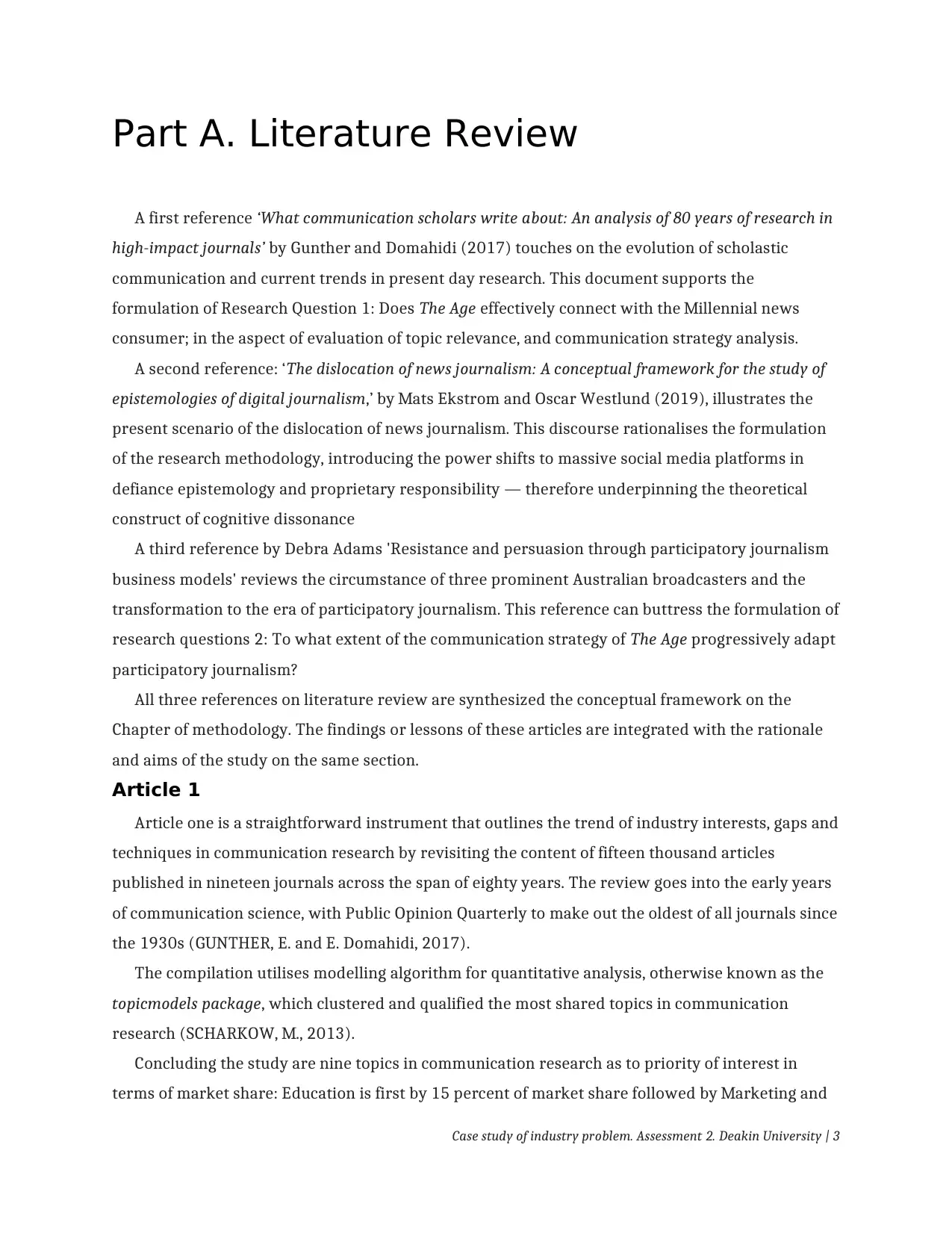
Part A. Literature Review
A first reference ‘What communication scholars write about: An analysis of 80 years of research in
high-impact journals’ by Gunther and Domahidi (2017) touches on the evolution of scholastic
communication and current trends in present day research. This document supports the
formulation of Research Question 1: Does The Age effectively connect with the Millennial news
consumer; in the aspect of evaluation of topic relevance, and communication strategy analysis.
A second reference: ‘The dislocation of news journalism: A conceptual framework for the study of
epistemologies of digital journalism,’ by Mats Ekstrom and Oscar Westlund (2019), illustrates the
present scenario of the dislocation of news journalism. This discourse rationalises the formulation
of the research methodology, introducing the power shifts to massive social media platforms in
defiance epistemology and proprietary responsibility — therefore underpinning the theoretical
construct of cognitive dissonance
A third reference by Debra Adams 'Resistance and persuasion through participatory journalism
business models' reviews the circumstance of three prominent Australian broadcasters and the
transformation to the era of participatory journalism. This reference can buttress the formulation of
research questions 2: To what extent of the communication strategy of The Age progressively adapt
participatory journalism?
All three references on literature review are synthesized the conceptual framework on the
Chapter of methodology. The findings or lessons of these articles are integrated with the rationale
and aims of the study on the same section.
Article 1
Article one is a straightforward instrument that outlines the trend of industry interests, gaps and
techniques in communication research by revisiting the content of fifteen thousand articles
published in nineteen journals across the span of eighty years. The review goes into the early years
of communication science, with Public Opinion Quarterly to make out the oldest of all journals since
the 1930s (GUNTHER, E. and E. Domahidi, 2017).
The compilation utilises modelling algorithm for quantitative analysis, otherwise known as the
topicmodels package, which clustered and qualified the most shared topics in communication
research (SCHARKOW, M., 2013).
Concluding the study are nine topics in communication research as to priority of interest in
terms of market share: Education is first by 15 percent of market share followed by Marketing and
Case study of industry problem. Assessment 2. Deakin University | 3
A first reference ‘What communication scholars write about: An analysis of 80 years of research in
high-impact journals’ by Gunther and Domahidi (2017) touches on the evolution of scholastic
communication and current trends in present day research. This document supports the
formulation of Research Question 1: Does The Age effectively connect with the Millennial news
consumer; in the aspect of evaluation of topic relevance, and communication strategy analysis.
A second reference: ‘The dislocation of news journalism: A conceptual framework for the study of
epistemologies of digital journalism,’ by Mats Ekstrom and Oscar Westlund (2019), illustrates the
present scenario of the dislocation of news journalism. This discourse rationalises the formulation
of the research methodology, introducing the power shifts to massive social media platforms in
defiance epistemology and proprietary responsibility — therefore underpinning the theoretical
construct of cognitive dissonance
A third reference by Debra Adams 'Resistance and persuasion through participatory journalism
business models' reviews the circumstance of three prominent Australian broadcasters and the
transformation to the era of participatory journalism. This reference can buttress the formulation of
research questions 2: To what extent of the communication strategy of The Age progressively adapt
participatory journalism?
All three references on literature review are synthesized the conceptual framework on the
Chapter of methodology. The findings or lessons of these articles are integrated with the rationale
and aims of the study on the same section.
Article 1
Article one is a straightforward instrument that outlines the trend of industry interests, gaps and
techniques in communication research by revisiting the content of fifteen thousand articles
published in nineteen journals across the span of eighty years. The review goes into the early years
of communication science, with Public Opinion Quarterly to make out the oldest of all journals since
the 1930s (GUNTHER, E. and E. Domahidi, 2017).
The compilation utilises modelling algorithm for quantitative analysis, otherwise known as the
topicmodels package, which clustered and qualified the most shared topics in communication
research (SCHARKOW, M., 2013).
Concluding the study are nine topics in communication research as to priority of interest in
terms of market share: Education is first by 15 percent of market share followed by Marketing and
Case study of industry problem. Assessment 2. Deakin University | 3
⊘ This is a preview!⊘
Do you want full access?
Subscribe today to unlock all pages.

Trusted by 1+ million students worldwide
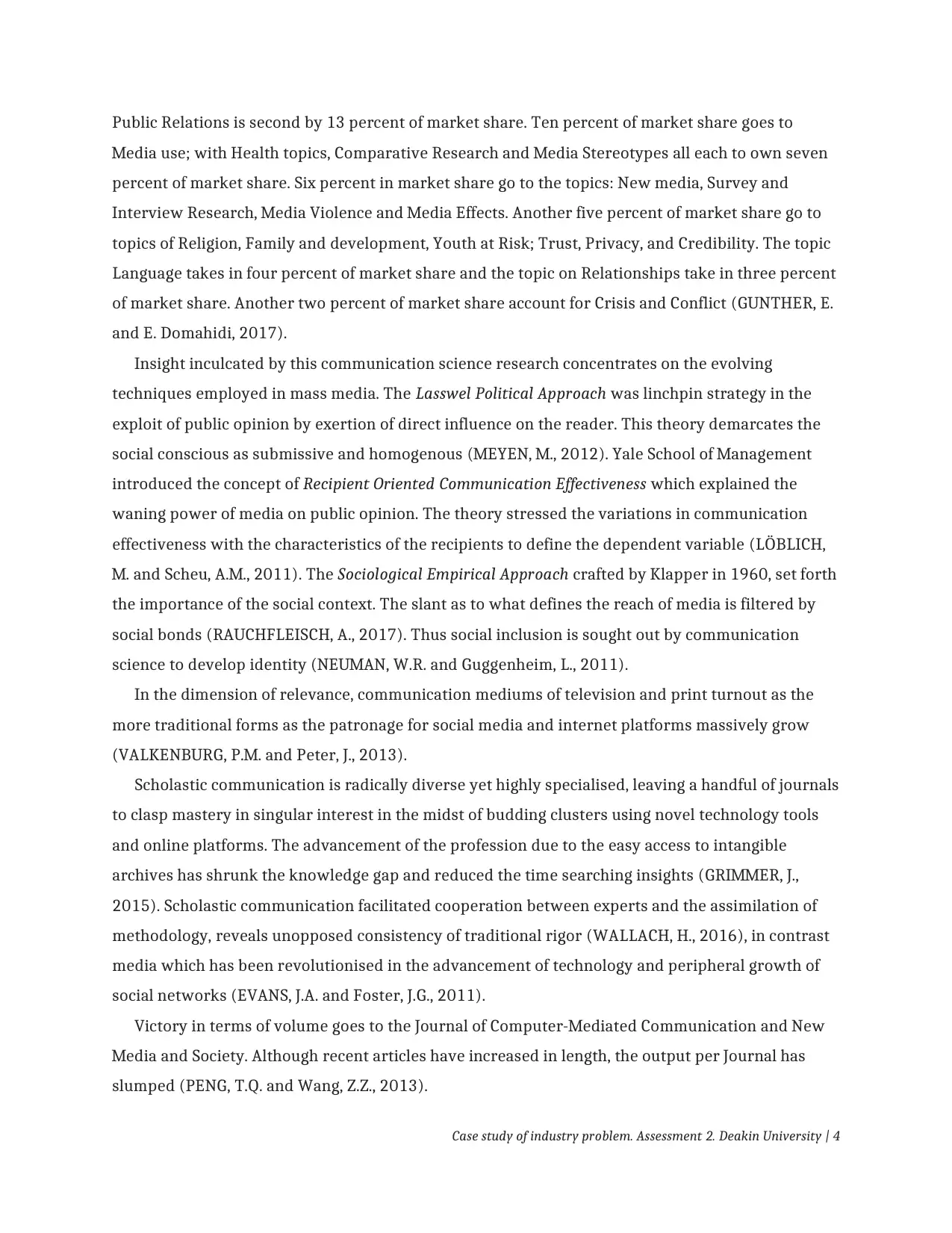
Public Relations is second by 13 percent of market share. Ten percent of market share goes to
Media use; with Health topics, Comparative Research and Media Stereotypes all each to own seven
percent of market share. Six percent in market share go to the topics: New media, Survey and
Interview Research, Media Violence and Media Effects. Another five percent of market share go to
topics of Religion, Family and development, Youth at Risk; Trust, Privacy, and Credibility. The topic
Language takes in four percent of market share and the topic on Relationships take in three percent
of market share. Another two percent of market share account for Crisis and Conflict (GUNTHER, E.
and E. Domahidi, 2017).
Insight inculcated by this communication science research concentrates on the evolving
techniques employed in mass media. The Lasswel Political Approach was linchpin strategy in the
exploit of public opinion by exertion of direct influence on the reader. This theory demarcates the
social conscious as submissive and homogenous (MEYEN, M., 2012). Yale School of Management
introduced the concept of Recipient Oriented Communication Effectiveness which explained the
waning power of media on public opinion. The theory stressed the variations in communication
effectiveness with the characteristics of the recipients to define the dependent variable (LÖBLICH,
M. and Scheu, A.M., 2011). The Sociological Empirical Approach crafted by Klapper in 1960, set forth
the importance of the social context. The slant as to what defines the reach of media is filtered by
social bonds (RAUCHFLEISCH, A., 2017). Thus social inclusion is sought out by communication
science to develop identity (NEUMAN, W.R. and Guggenheim, L., 2011).
In the dimension of relevance, communication mediums of television and print turnout as the
more traditional forms as the patronage for social media and internet platforms massively grow
(VALKENBURG, P.M. and Peter, J., 2013).
Scholastic communication is radically diverse yet highly specialised, leaving a handful of journals
to clasp mastery in singular interest in the midst of budding clusters using novel technology tools
and online platforms. The advancement of the profession due to the easy access to intangible
archives has shrunk the knowledge gap and reduced the time searching insights (GRIMMER, J.,
2015). Scholastic communication facilitated cooperation between experts and the assimilation of
methodology, reveals unopposed consistency of traditional rigor (WALLACH, H., 2016), in contrast
media which has been revolutionised in the advancement of technology and peripheral growth of
social networks (EVANS, J.A. and Foster, J.G., 2011).
Victory in terms of volume goes to the Journal of Computer-Mediated Communication and New
Media and Society. Although recent articles have increased in length, the output per Journal has
slumped (PENG, T.Q. and Wang, Z.Z., 2013).
Case study of industry problem. Assessment 2. Deakin University | 4
Media use; with Health topics, Comparative Research and Media Stereotypes all each to own seven
percent of market share. Six percent in market share go to the topics: New media, Survey and
Interview Research, Media Violence and Media Effects. Another five percent of market share go to
topics of Religion, Family and development, Youth at Risk; Trust, Privacy, and Credibility. The topic
Language takes in four percent of market share and the topic on Relationships take in three percent
of market share. Another two percent of market share account for Crisis and Conflict (GUNTHER, E.
and E. Domahidi, 2017).
Insight inculcated by this communication science research concentrates on the evolving
techniques employed in mass media. The Lasswel Political Approach was linchpin strategy in the
exploit of public opinion by exertion of direct influence on the reader. This theory demarcates the
social conscious as submissive and homogenous (MEYEN, M., 2012). Yale School of Management
introduced the concept of Recipient Oriented Communication Effectiveness which explained the
waning power of media on public opinion. The theory stressed the variations in communication
effectiveness with the characteristics of the recipients to define the dependent variable (LÖBLICH,
M. and Scheu, A.M., 2011). The Sociological Empirical Approach crafted by Klapper in 1960, set forth
the importance of the social context. The slant as to what defines the reach of media is filtered by
social bonds (RAUCHFLEISCH, A., 2017). Thus social inclusion is sought out by communication
science to develop identity (NEUMAN, W.R. and Guggenheim, L., 2011).
In the dimension of relevance, communication mediums of television and print turnout as the
more traditional forms as the patronage for social media and internet platforms massively grow
(VALKENBURG, P.M. and Peter, J., 2013).
Scholastic communication is radically diverse yet highly specialised, leaving a handful of journals
to clasp mastery in singular interest in the midst of budding clusters using novel technology tools
and online platforms. The advancement of the profession due to the easy access to intangible
archives has shrunk the knowledge gap and reduced the time searching insights (GRIMMER, J.,
2015). Scholastic communication facilitated cooperation between experts and the assimilation of
methodology, reveals unopposed consistency of traditional rigor (WALLACH, H., 2016), in contrast
media which has been revolutionised in the advancement of technology and peripheral growth of
social networks (EVANS, J.A. and Foster, J.G., 2011).
Victory in terms of volume goes to the Journal of Computer-Mediated Communication and New
Media and Society. Although recent articles have increased in length, the output per Journal has
slumped (PENG, T.Q. and Wang, Z.Z., 2013).
Case study of industry problem. Assessment 2. Deakin University | 4
Paraphrase This Document
Need a fresh take? Get an instant paraphrase of this document with our AI Paraphraser
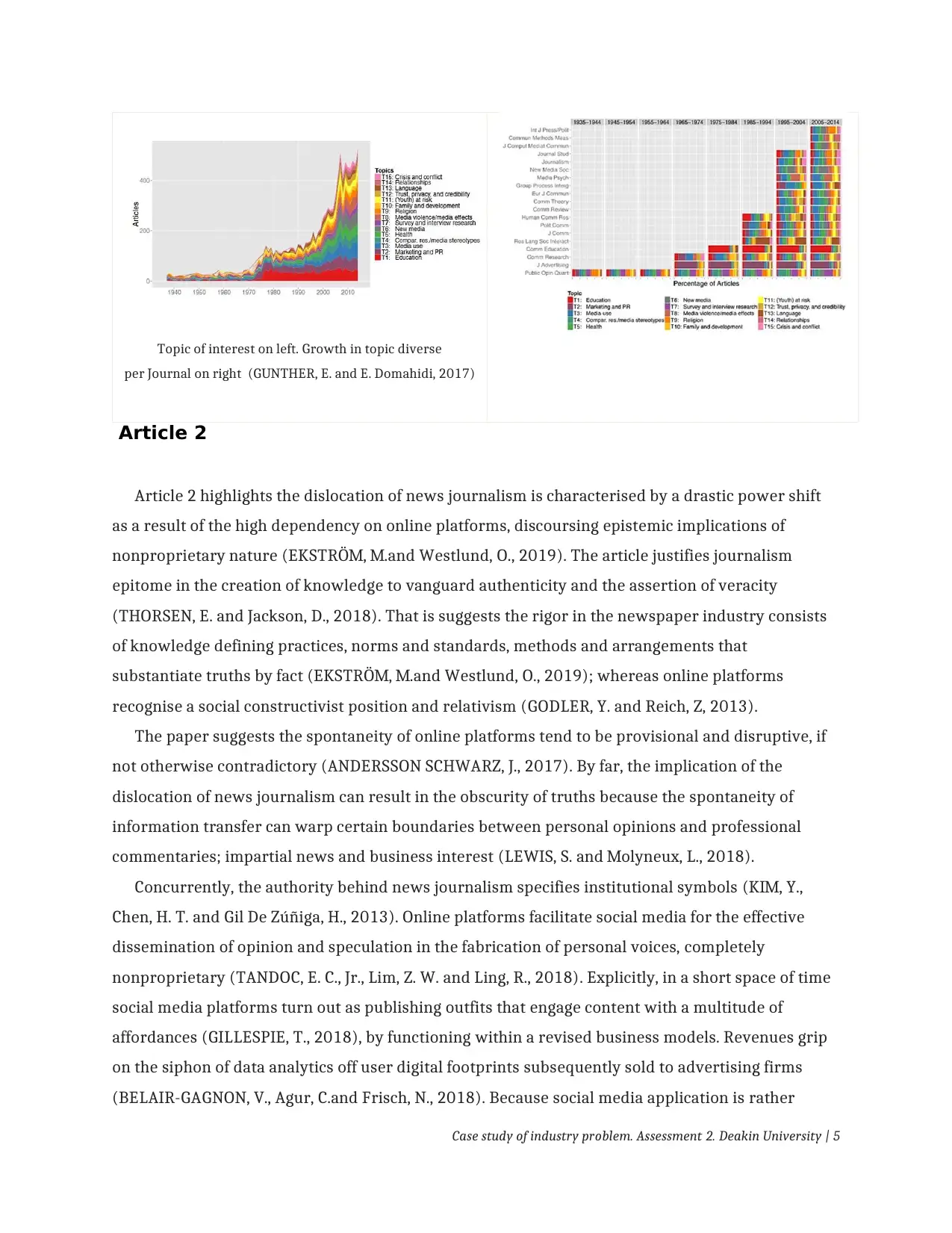
Topic of interest on left. Growth in topic diverse
per Journal on right (GUNTHER, E. and E. Domahidi, 2017)
Article 2
Article 2 highlights the dislocation of news journalism is characterised by a drastic power shift
as a result of the high dependency on online platforms, discoursing epistemic implications of
nonproprietary nature (EKSTRÖM, M.and Westlund, O., 2019). The article justifies journalism
epitome in the creation of knowledge to vanguard authenticity and the assertion of veracity
(THORSEN, E. and Jackson, D., 2018). That is suggests the rigor in the newspaper industry consists
of knowledge defining practices, norms and standards, methods and arrangements that
substantiate truths by fact (EKSTRÖM, M.and Westlund, O., 2019); whereas online platforms
recognise a social constructivist position and relativism (GODLER, Y. and Reich, Z, 2013).
The paper suggests the spontaneity of online platforms tend to be provisional and disruptive, if
not otherwise contradictory (ANDERSSON SCHWARZ, J., 2017). By far, the implication of the
dislocation of news journalism can result in the obscurity of truths because the spontaneity of
information transfer can warp certain boundaries between personal opinions and professional
commentaries; impartial news and business interest (LEWIS, S. and Molyneux, L., 2018).
Concurrently, the authority behind news journalism specifies institutional symbols (KIM, Y.,
Chen, H. T. and Gil De Zúñiga, H., 2013). Online platforms facilitate social media for the effective
dissemination of opinion and speculation in the fabrication of personal voices, completely
nonproprietary (TANDOC, E. C., Jr., Lim, Z. W. and Ling, R., 2018). Explicitly, in a short space of time
social media platforms turn out as publishing outfits that engage content with a multitude of
affordances (GILLESPIE, T., 2018), by functioning within a revised business models. Revenues grip
on the siphon of data analytics off user digital footprints subsequently sold to advertising firms
(BELAIR-GAGNON, V., Agur, C.and Frisch, N., 2018). Because social media application is rather
Case study of industry problem. Assessment 2. Deakin University | 5
per Journal on right (GUNTHER, E. and E. Domahidi, 2017)
Article 2
Article 2 highlights the dislocation of news journalism is characterised by a drastic power shift
as a result of the high dependency on online platforms, discoursing epistemic implications of
nonproprietary nature (EKSTRÖM, M.and Westlund, O., 2019). The article justifies journalism
epitome in the creation of knowledge to vanguard authenticity and the assertion of veracity
(THORSEN, E. and Jackson, D., 2018). That is suggests the rigor in the newspaper industry consists
of knowledge defining practices, norms and standards, methods and arrangements that
substantiate truths by fact (EKSTRÖM, M.and Westlund, O., 2019); whereas online platforms
recognise a social constructivist position and relativism (GODLER, Y. and Reich, Z, 2013).
The paper suggests the spontaneity of online platforms tend to be provisional and disruptive, if
not otherwise contradictory (ANDERSSON SCHWARZ, J., 2017). By far, the implication of the
dislocation of news journalism can result in the obscurity of truths because the spontaneity of
information transfer can warp certain boundaries between personal opinions and professional
commentaries; impartial news and business interest (LEWIS, S. and Molyneux, L., 2018).
Concurrently, the authority behind news journalism specifies institutional symbols (KIM, Y.,
Chen, H. T. and Gil De Zúñiga, H., 2013). Online platforms facilitate social media for the effective
dissemination of opinion and speculation in the fabrication of personal voices, completely
nonproprietary (TANDOC, E. C., Jr., Lim, Z. W. and Ling, R., 2018). Explicitly, in a short space of time
social media platforms turn out as publishing outfits that engage content with a multitude of
affordances (GILLESPIE, T., 2018), by functioning within a revised business models. Revenues grip
on the siphon of data analytics off user digital footprints subsequently sold to advertising firms
(BELAIR-GAGNON, V., Agur, C.and Frisch, N., 2018). Because social media application is rather
Case study of industry problem. Assessment 2. Deakin University | 5
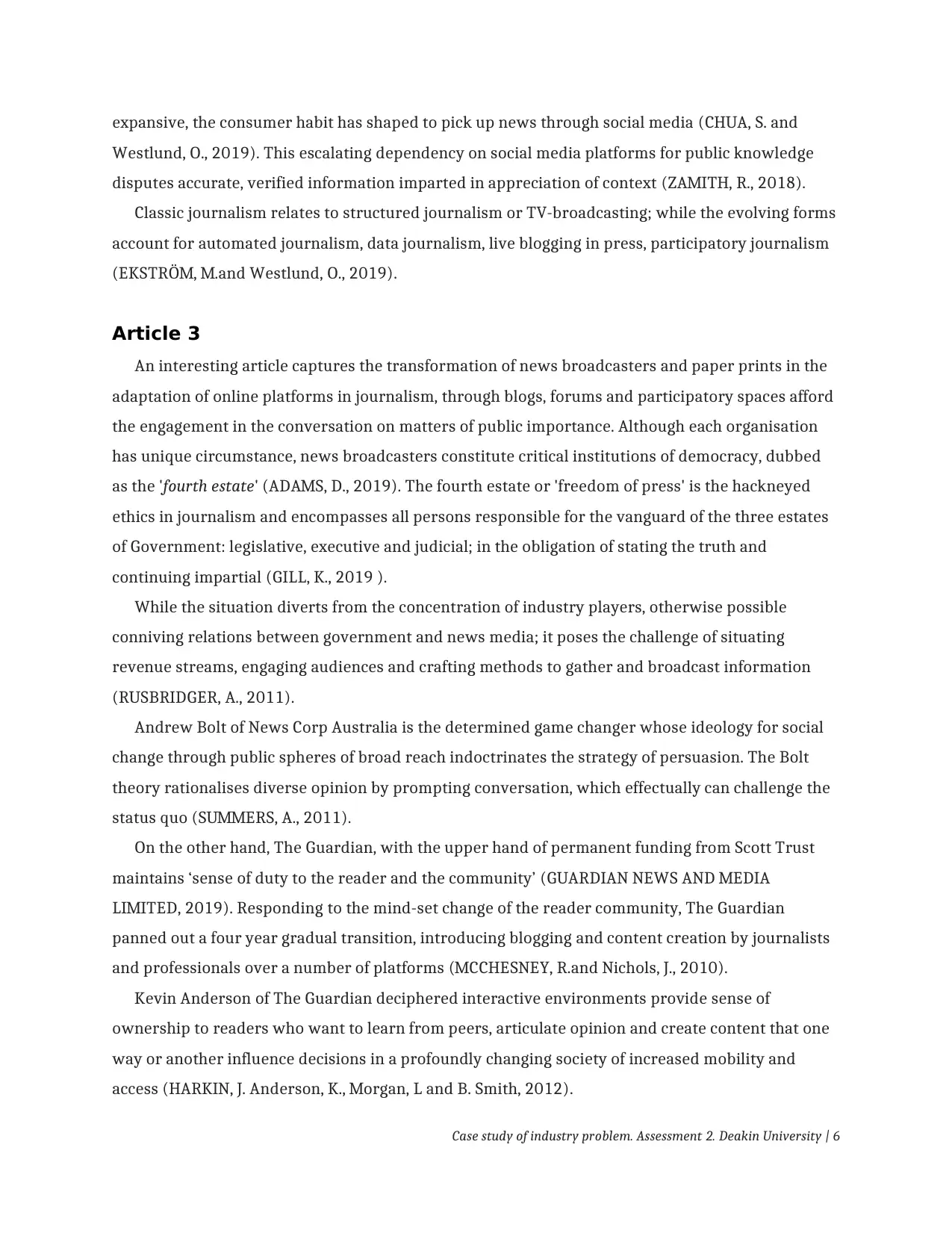
expansive, the consumer habit has shaped to pick up news through social media (CHUA, S. and
Westlund, O., 2019). This escalating dependency on social media platforms for public knowledge
disputes accurate, verified information imparted in appreciation of context (ZAMITH, R., 2018).
Classic journalism relates to structured journalism or TV-broadcasting; while the evolving forms
account for automated journalism, data journalism, live blogging in press, participatory journalism
(EKSTRÖM, M.and Westlund, O., 2019).
Article 3
An interesting article captures the transformation of news broadcasters and paper prints in the
adaptation of online platforms in journalism, through blogs, forums and participatory spaces afford
the engagement in the conversation on matters of public importance. Although each organisation
has unique circumstance, news broadcasters constitute critical institutions of democracy, dubbed
as the 'fourth estate' (ADAMS, D., 2019). The fourth estate or 'freedom of press' is the hackneyed
ethics in journalism and encompasses all persons responsible for the vanguard of the three estates
of Government: legislative, executive and judicial; in the obligation of stating the truth and
continuing impartial (GILL, K., 2019 ).
While the situation diverts from the concentration of industry players, otherwise possible
conniving relations between government and news media; it poses the challenge of situating
revenue streams, engaging audiences and crafting methods to gather and broadcast information
(RUSBRIDGER, A., 2011).
Andrew Bolt of News Corp Australia is the determined game changer whose ideology for social
change through public spheres of broad reach indoctrinates the strategy of persuasion. The Bolt
theory rationalises diverse opinion by prompting conversation, which effectually can challenge the
status quo (SUMMERS, A., 2011).
On the other hand, The Guardian, with the upper hand of permanent funding from Scott Trust
maintains ‘sense of duty to the reader and the community’ (GUARDIAN NEWS AND MEDIA
LIMITED, 2019). Responding to the mind-set change of the reader community, The Guardian
panned out a four year gradual transition, introducing blogging and content creation by journalists
and professionals over a number of platforms (MCCHESNEY, R.and Nichols, J., 2010).
Kevin Anderson of The Guardian deciphered interactive environments provide sense of
ownership to readers who want to learn from peers, articulate opinion and create content that one
way or another influence decisions in a profoundly changing society of increased mobility and
access (HARKIN, J. Anderson, K., Morgan, L and B. Smith, 2012).
Case study of industry problem. Assessment 2. Deakin University | 6
Westlund, O., 2019). This escalating dependency on social media platforms for public knowledge
disputes accurate, verified information imparted in appreciation of context (ZAMITH, R., 2018).
Classic journalism relates to structured journalism or TV-broadcasting; while the evolving forms
account for automated journalism, data journalism, live blogging in press, participatory journalism
(EKSTRÖM, M.and Westlund, O., 2019).
Article 3
An interesting article captures the transformation of news broadcasters and paper prints in the
adaptation of online platforms in journalism, through blogs, forums and participatory spaces afford
the engagement in the conversation on matters of public importance. Although each organisation
has unique circumstance, news broadcasters constitute critical institutions of democracy, dubbed
as the 'fourth estate' (ADAMS, D., 2019). The fourth estate or 'freedom of press' is the hackneyed
ethics in journalism and encompasses all persons responsible for the vanguard of the three estates
of Government: legislative, executive and judicial; in the obligation of stating the truth and
continuing impartial (GILL, K., 2019 ).
While the situation diverts from the concentration of industry players, otherwise possible
conniving relations between government and news media; it poses the challenge of situating
revenue streams, engaging audiences and crafting methods to gather and broadcast information
(RUSBRIDGER, A., 2011).
Andrew Bolt of News Corp Australia is the determined game changer whose ideology for social
change through public spheres of broad reach indoctrinates the strategy of persuasion. The Bolt
theory rationalises diverse opinion by prompting conversation, which effectually can challenge the
status quo (SUMMERS, A., 2011).
On the other hand, The Guardian, with the upper hand of permanent funding from Scott Trust
maintains ‘sense of duty to the reader and the community’ (GUARDIAN NEWS AND MEDIA
LIMITED, 2019). Responding to the mind-set change of the reader community, The Guardian
panned out a four year gradual transition, introducing blogging and content creation by journalists
and professionals over a number of platforms (MCCHESNEY, R.and Nichols, J., 2010).
Kevin Anderson of The Guardian deciphered interactive environments provide sense of
ownership to readers who want to learn from peers, articulate opinion and create content that one
way or another influence decisions in a profoundly changing society of increased mobility and
access (HARKIN, J. Anderson, K., Morgan, L and B. Smith, 2012).
Case study of industry problem. Assessment 2. Deakin University | 6
⊘ This is a preview!⊘
Do you want full access?
Subscribe today to unlock all pages.

Trusted by 1+ million students worldwide
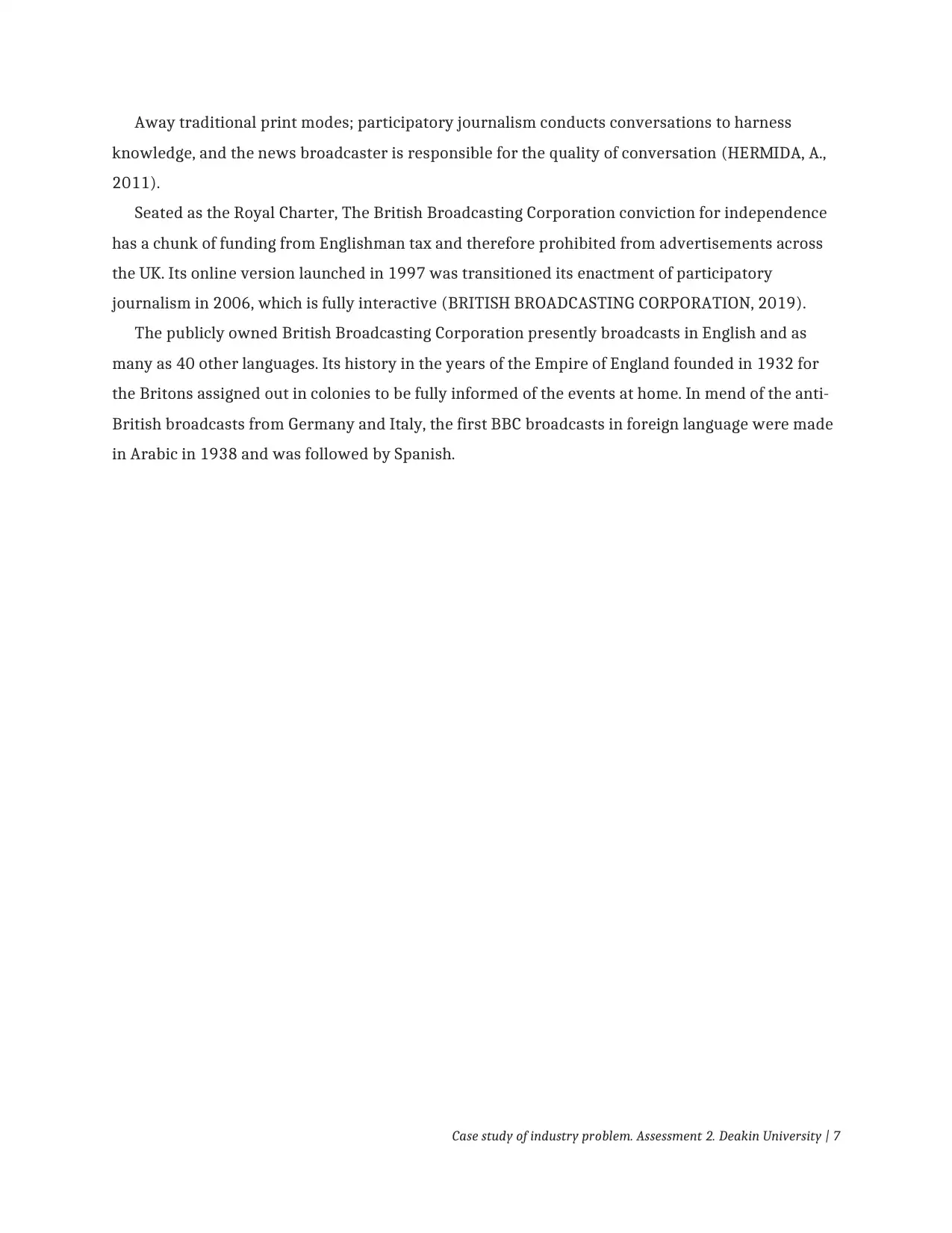
Away traditional print modes; participatory journalism conducts conversations to harness
knowledge, and the news broadcaster is responsible for the quality of conversation (HERMIDA, A.,
2011).
Seated as the Royal Charter, The British Broadcasting Corporation conviction for independence
has a chunk of funding from Englishman tax and therefore prohibited from advertisements across
the UK. Its online version launched in 1997 was transitioned its enactment of participatory
journalism in 2006, which is fully interactive (BRITISH BROADCASTING CORPORATION, 2019).
The publicly owned British Broadcasting Corporation presently broadcasts in English and as
many as 40 other languages. Its history in the years of the Empire of England founded in 1932 for
the Britons assigned out in colonies to be fully informed of the events at home. In mend of the anti-
British broadcasts from Germany and Italy, the first BBC broadcasts in foreign language were made
in Arabic in 1938 and was followed by Spanish.
Case study of industry problem. Assessment 2. Deakin University | 7
knowledge, and the news broadcaster is responsible for the quality of conversation (HERMIDA, A.,
2011).
Seated as the Royal Charter, The British Broadcasting Corporation conviction for independence
has a chunk of funding from Englishman tax and therefore prohibited from advertisements across
the UK. Its online version launched in 1997 was transitioned its enactment of participatory
journalism in 2006, which is fully interactive (BRITISH BROADCASTING CORPORATION, 2019).
The publicly owned British Broadcasting Corporation presently broadcasts in English and as
many as 40 other languages. Its history in the years of the Empire of England founded in 1932 for
the Britons assigned out in colonies to be fully informed of the events at home. In mend of the anti-
British broadcasts from Germany and Italy, the first BBC broadcasts in foreign language were made
in Arabic in 1938 and was followed by Spanish.
Case study of industry problem. Assessment 2. Deakin University | 7
Paraphrase This Document
Need a fresh take? Get an instant paraphrase of this document with our AI Paraphraser
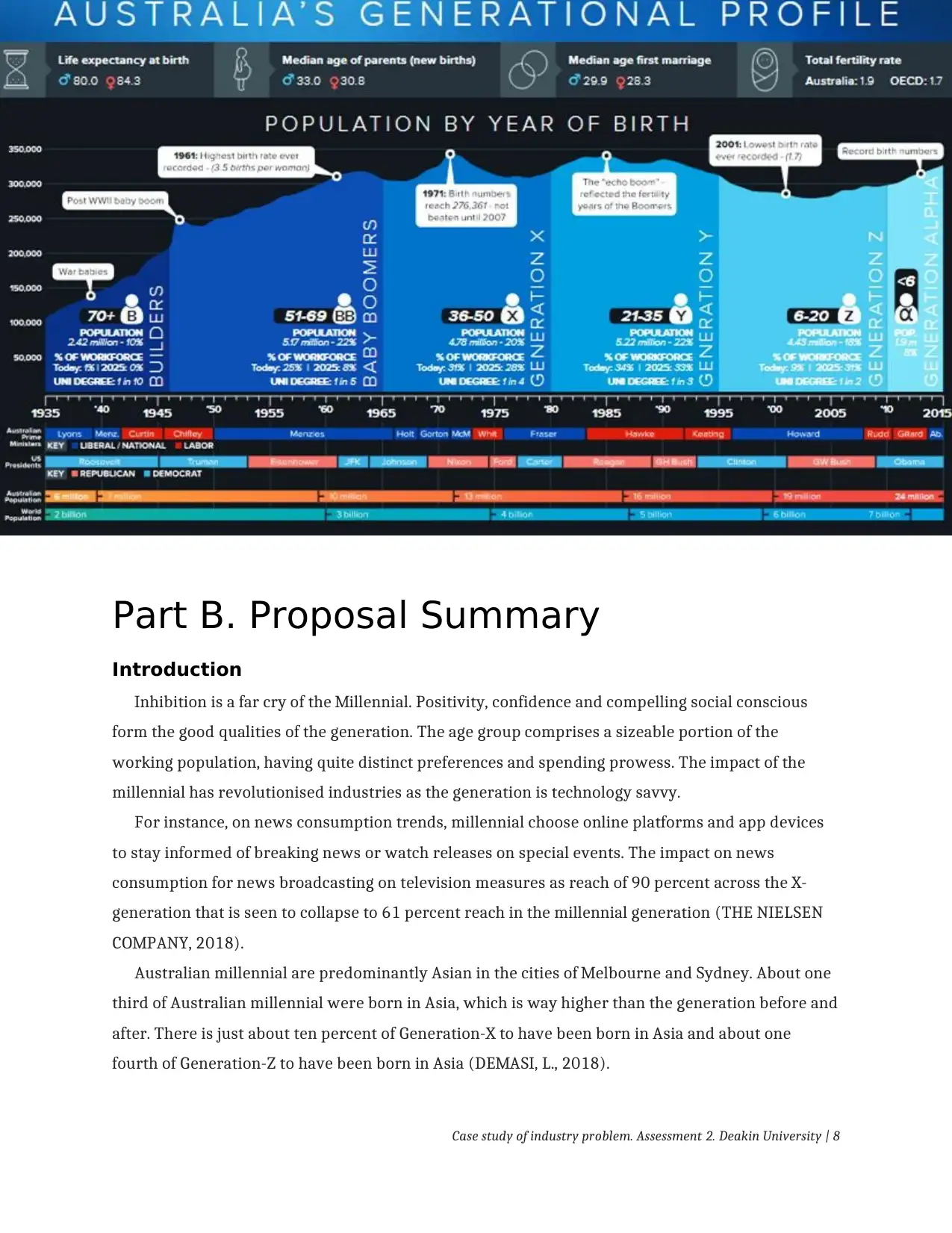
Part B. Proposal Summary
Introduction
Inhibition is a far cry of the Millennial. Positivity, confidence and compelling social conscious
form the good qualities of the generation. The age group comprises a sizeable portion of the
working population, having quite distinct preferences and spending prowess. The impact of the
millennial has revolutionised industries as the generation is technology savvy.
For instance, on news consumption trends, millennial choose online platforms and app devices
to stay informed of breaking news or watch releases on special events. The impact on news
consumption for news broadcasting on television measures as reach of 90 percent across the X-
generation that is seen to collapse to 61 percent reach in the millennial generation (THE NIELSEN
COMPANY, 2018).
Australian millennial are predominantly Asian in the cities of Melbourne and Sydney. About one
third of Australian millennial were born in Asia, which is way higher than the generation before and
after. There is just about ten percent of Generation-X to have been born in Asia and about one
fourth of Generation-Z to have been born in Asia (DEMASI, L., 2018).
Case study of industry problem. Assessment 2. Deakin University | 8
Introduction
Inhibition is a far cry of the Millennial. Positivity, confidence and compelling social conscious
form the good qualities of the generation. The age group comprises a sizeable portion of the
working population, having quite distinct preferences and spending prowess. The impact of the
millennial has revolutionised industries as the generation is technology savvy.
For instance, on news consumption trends, millennial choose online platforms and app devices
to stay informed of breaking news or watch releases on special events. The impact on news
consumption for news broadcasting on television measures as reach of 90 percent across the X-
generation that is seen to collapse to 61 percent reach in the millennial generation (THE NIELSEN
COMPANY, 2018).
Australian millennial are predominantly Asian in the cities of Melbourne and Sydney. About one
third of Australian millennial were born in Asia, which is way higher than the generation before and
after. There is just about ten percent of Generation-X to have been born in Asia and about one
fourth of Generation-Z to have been born in Asia (DEMASI, L., 2018).
Case study of industry problem. Assessment 2. Deakin University | 8

A few trends are noted to have gone up. Traditional marriage is one trend up for the millennial.
Seven in ten Asian born Australian millennial are married when compared to the Australian born
millennial that is about four in ten. Asian born Australian Millennials are light spenders,
conservative in the aspect of same sex marriage and bravely support the Liberal party. It is to note
that half o millennial born in China do not watch commercial television (DEMASI, L., 2018).
Composition of Australian Millennial
Age group between 21and 35, defined as generation Y otherwise the Millennial, account for 5.22
million Australians comprising 22 percent of the full ‘six generations population’ and occupy 34
percent of country economically active group (MCCRINDLE RESEARCH PTY LTD , 2015)
Trust in News
Fletcher (2017) review on the impact analysis on trust in news media in six economically
advanced nations; the proliferation of online news is at 94 percent in Australia. With a sample size
of 22,507,617 Australians, the preference mainstream news sources recognise 83.8 percent. There
is a high score on the aspect 'Trust in news' at 36.9 percent, followed by a moderate score of 30
percent. Only 23.1 percent of Australians scored 'Trust in news' low and 7.7 percent very low. A
majority of Australians opt for mainstream news sources with 77.6 percent and only 22.4 percent
go to nonmainstream users. There is a strong preference for online platforms hosting participatory
news journalism with 42.9 of Australians wanting sharing and feedback; and 30.6 percent looking
into comment or contribution. Nearly half of online users or 49.6 percent choose to be passive
(FLETCHER, R. and Park,S., 2017).
Aims and Rationale
Rationale
Epistemology as a discipline of news journalism is proprietary, specifically in sense of
responsibility, as being responsible for the conversation. Equal to that is the fourth estate that
places the industry of news journalism accountable for the quality of such conversations. Power
rests in the dictum of the people and therefore is the property of the social construct reflective of
the real world; insofar journalism is but sheer instrumental.
Aim
The aim in this study is to qualify the extent of participatory journalism endeavoured by The Age
on the Australian Millennials.
Case study of industry problem. Assessment 2. Deakin University | 9
Seven in ten Asian born Australian millennial are married when compared to the Australian born
millennial that is about four in ten. Asian born Australian Millennials are light spenders,
conservative in the aspect of same sex marriage and bravely support the Liberal party. It is to note
that half o millennial born in China do not watch commercial television (DEMASI, L., 2018).
Composition of Australian Millennial
Age group between 21and 35, defined as generation Y otherwise the Millennial, account for 5.22
million Australians comprising 22 percent of the full ‘six generations population’ and occupy 34
percent of country economically active group (MCCRINDLE RESEARCH PTY LTD , 2015)
Trust in News
Fletcher (2017) review on the impact analysis on trust in news media in six economically
advanced nations; the proliferation of online news is at 94 percent in Australia. With a sample size
of 22,507,617 Australians, the preference mainstream news sources recognise 83.8 percent. There
is a high score on the aspect 'Trust in news' at 36.9 percent, followed by a moderate score of 30
percent. Only 23.1 percent of Australians scored 'Trust in news' low and 7.7 percent very low. A
majority of Australians opt for mainstream news sources with 77.6 percent and only 22.4 percent
go to nonmainstream users. There is a strong preference for online platforms hosting participatory
news journalism with 42.9 of Australians wanting sharing and feedback; and 30.6 percent looking
into comment or contribution. Nearly half of online users or 49.6 percent choose to be passive
(FLETCHER, R. and Park,S., 2017).
Aims and Rationale
Rationale
Epistemology as a discipline of news journalism is proprietary, specifically in sense of
responsibility, as being responsible for the conversation. Equal to that is the fourth estate that
places the industry of news journalism accountable for the quality of such conversations. Power
rests in the dictum of the people and therefore is the property of the social construct reflective of
the real world; insofar journalism is but sheer instrumental.
Aim
The aim in this study is to qualify the extent of participatory journalism endeavoured by The Age
on the Australian Millennials.
Case study of industry problem. Assessment 2. Deakin University | 9
⊘ This is a preview!⊘
Do you want full access?
Subscribe today to unlock all pages.

Trusted by 1+ million students worldwide

Background
A world’s dozen great newspapers between 1966 and 1975, The Age lords the Australian media
industry in the state of Victoria with the markings of liberal social conscious and strong
representative institutions; thus far toppling The Herald since1890 and once The Argus that ceased
publication in 1960 (CHANDLER, J., 2018 ).
The Age online platform registers over seven million guests monthly and ranks seven as most
visited Australian news websites. Its weekly paper circulation is an average of 715000 with 21.2
percent of circulation on Saturdays and 17.2 on Sundays (similarweb.com/website/theage.com.au).
Running three editions nightly, The Age printed an interstate edition the NAA, country Victorian
edition the MEA, and the metropolitan edition the THA since 2012 but in a smaller Berliner size
since 2007 (SIMILARWEB LTD , 2014).
Founded by Walter Powell, John Cooke and Henry Cooke in the early 1940s, The Age Company
Ltd was assumed by the Syme family in October 1854. Fairfax Media acquisitioned the outfit in
1983 that underwent merger with Nine Entertainment Company disposing 51.1 percent ownership
(CARRETT, J., 2018).
The Age had been tremendously instrumental in the development of Australia as a potent force
long before participatory journalism came into play; with The Age Independence Committee at
helm. The paper espoused to shape social conscious on crucial and otherwise controversial issues
such as: the White Australia policy and freedom of commerce; the Australian federation and the
manufacturing industries tariff barriers; freedom of religion and freedom of personal action
compatible with public morality (NOLAN, S., 2001).
Through generations, it had distinct political identity exercising conviction to the leadership:
Graham Berry and George Higinbotham; George Turner and Alfred Deakin; Malcolm Fraser and Bob
Hawke. As a formidable patriot The Age advocated for Free David Hicks campaign as Guantanamo
Bay prisoner and Iraq hostage of Douglas Wood; the Vienna Boys Choir and the substantial
donation for the build of a mosque in Doveton (NOLAN, S., 2001).
Research Questions
Research Question 1: Does The Age effectively connect with the millennial news consumer?
Research Question 2: To what extent of the communication strategy of The Age adapt
participatory journalism?
Case study of industry problem. Assessment 2. Deakin University | 10
A world’s dozen great newspapers between 1966 and 1975, The Age lords the Australian media
industry in the state of Victoria with the markings of liberal social conscious and strong
representative institutions; thus far toppling The Herald since1890 and once The Argus that ceased
publication in 1960 (CHANDLER, J., 2018 ).
The Age online platform registers over seven million guests monthly and ranks seven as most
visited Australian news websites. Its weekly paper circulation is an average of 715000 with 21.2
percent of circulation on Saturdays and 17.2 on Sundays (similarweb.com/website/theage.com.au).
Running three editions nightly, The Age printed an interstate edition the NAA, country Victorian
edition the MEA, and the metropolitan edition the THA since 2012 but in a smaller Berliner size
since 2007 (SIMILARWEB LTD , 2014).
Founded by Walter Powell, John Cooke and Henry Cooke in the early 1940s, The Age Company
Ltd was assumed by the Syme family in October 1854. Fairfax Media acquisitioned the outfit in
1983 that underwent merger with Nine Entertainment Company disposing 51.1 percent ownership
(CARRETT, J., 2018).
The Age had been tremendously instrumental in the development of Australia as a potent force
long before participatory journalism came into play; with The Age Independence Committee at
helm. The paper espoused to shape social conscious on crucial and otherwise controversial issues
such as: the White Australia policy and freedom of commerce; the Australian federation and the
manufacturing industries tariff barriers; freedom of religion and freedom of personal action
compatible with public morality (NOLAN, S., 2001).
Through generations, it had distinct political identity exercising conviction to the leadership:
Graham Berry and George Higinbotham; George Turner and Alfred Deakin; Malcolm Fraser and Bob
Hawke. As a formidable patriot The Age advocated for Free David Hicks campaign as Guantanamo
Bay prisoner and Iraq hostage of Douglas Wood; the Vienna Boys Choir and the substantial
donation for the build of a mosque in Doveton (NOLAN, S., 2001).
Research Questions
Research Question 1: Does The Age effectively connect with the millennial news consumer?
Research Question 2: To what extent of the communication strategy of The Age adapt
participatory journalism?
Case study of industry problem. Assessment 2. Deakin University | 10
Paraphrase This Document
Need a fresh take? Get an instant paraphrase of this document with our AI Paraphraser
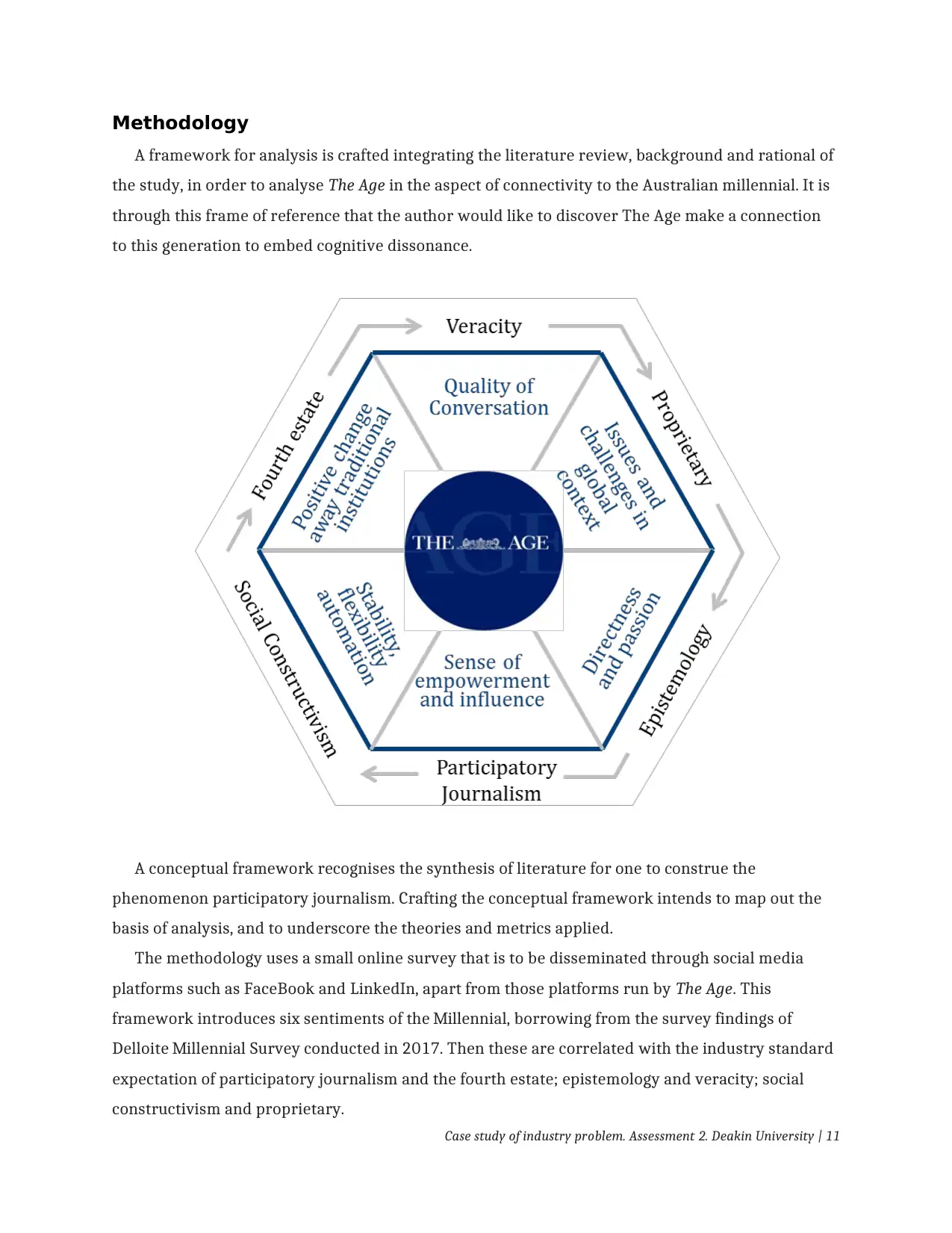
Methodology
A framework for analysis is crafted integrating the literature review, background and rational of
the study, in order to analyse The Age in the aspect of connectivity to the Australian millennial. It is
through this frame of reference that the author would like to discover The Age make a connection
to this generation to embed cognitive dissonance.
A conceptual framework recognises the synthesis of literature for one to construe the
phenomenon participatory journalism. Crafting the conceptual framework intends to map out the
basis of analysis, and to underscore the theories and metrics applied.
The methodology uses a small online survey that is to be disseminated through social media
platforms such as FaceBook and LinkedIn, apart from those platforms run by The Age. This
framework introduces six sentiments of the Millennial, borrowing from the survey findings of
Delloite Millennial Survey conducted in 2017. Then these are correlated with the industry standard
expectation of participatory journalism and the fourth estate; epistemology and veracity; social
constructivism and proprietary.
Case study of industry problem. Assessment 2. Deakin University | 11
A framework for analysis is crafted integrating the literature review, background and rational of
the study, in order to analyse The Age in the aspect of connectivity to the Australian millennial. It is
through this frame of reference that the author would like to discover The Age make a connection
to this generation to embed cognitive dissonance.
A conceptual framework recognises the synthesis of literature for one to construe the
phenomenon participatory journalism. Crafting the conceptual framework intends to map out the
basis of analysis, and to underscore the theories and metrics applied.
The methodology uses a small online survey that is to be disseminated through social media
platforms such as FaceBook and LinkedIn, apart from those platforms run by The Age. This
framework introduces six sentiments of the Millennial, borrowing from the survey findings of
Delloite Millennial Survey conducted in 2017. Then these are correlated with the industry standard
expectation of participatory journalism and the fourth estate; epistemology and veracity; social
constructivism and proprietary.
Case study of industry problem. Assessment 2. Deakin University | 11
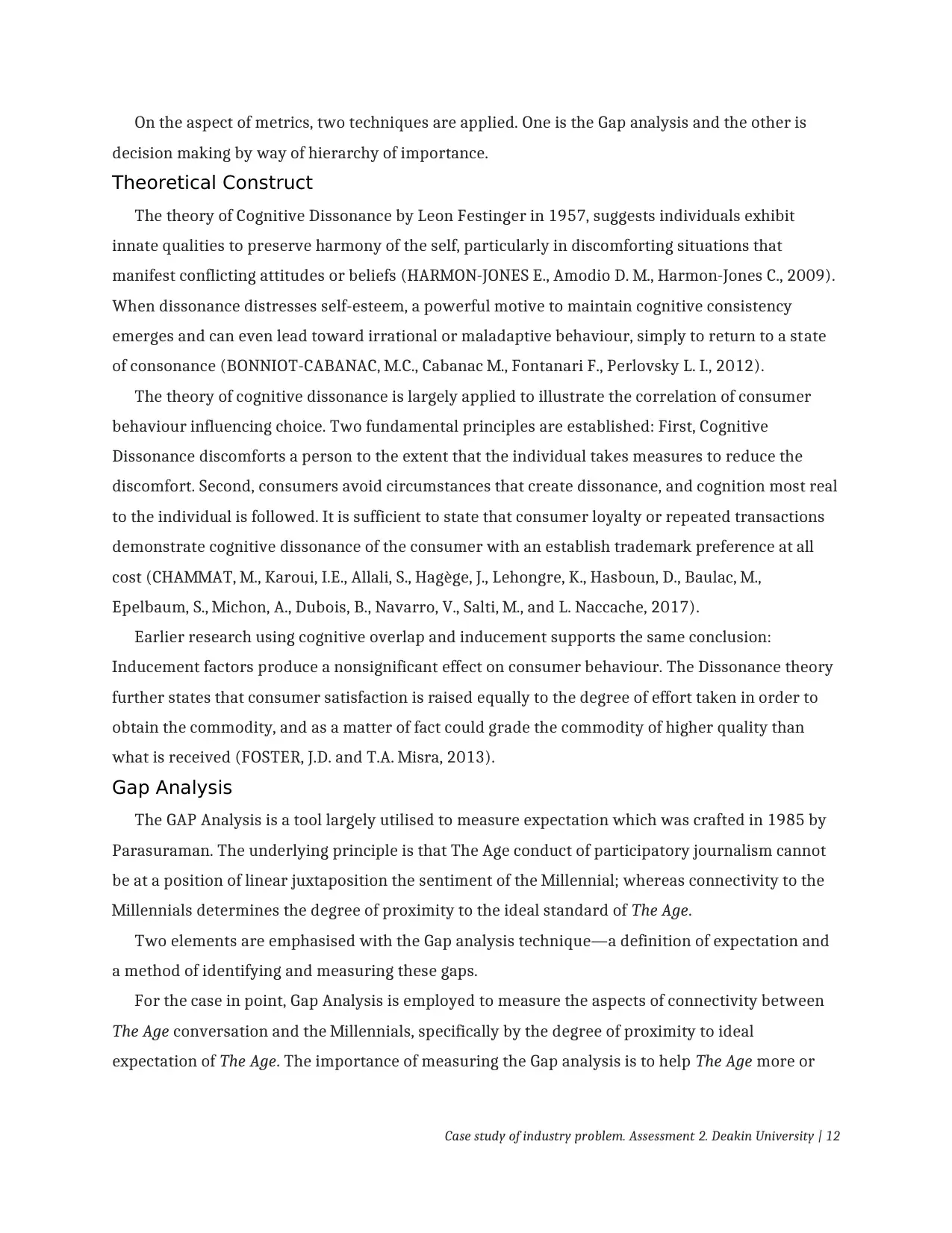
On the aspect of metrics, two techniques are applied. One is the Gap analysis and the other is
decision making by way of hierarchy of importance.
Theoretical Construct
The theory of Cognitive Dissonance by Leon Festinger in 1957, suggests individuals exhibit
innate qualities to preserve harmony of the self, particularly in discomforting situations that
manifest conflicting attitudes or beliefs (HARMON-JONES E., Amodio D. M., Harmon-Jones C., 2009).
When dissonance distresses self-esteem, a powerful motive to maintain cognitive consistency
emerges and can even lead toward irrational or maladaptive behaviour, simply to return to a state
of consonance (BONNIOT-CABANAC, M.C., Cabanac M., Fontanari F., Perlovsky L. I., 2012).
The theory of cognitive dissonance is largely applied to illustrate the correlation of consumer
behaviour influencing choice. Two fundamental principles are established: First, Cognitive
Dissonance discomforts a person to the extent that the individual takes measures to reduce the
discomfort. Second, consumers avoid circumstances that create dissonance, and cognition most real
to the individual is followed. It is sufficient to state that consumer loyalty or repeated transactions
demonstrate cognitive dissonance of the consumer with an establish trademark preference at all
cost (CHAMMAT, M., Karoui, I.E., Allali, S., Hagège, J., Lehongre, K., Hasboun, D., Baulac, M.,
Epelbaum, S., Michon, A., Dubois, B., Navarro, V., Salti, M., and L. Naccache, 2017).
Earlier research using cognitive overlap and inducement supports the same conclusion:
Inducement factors produce a nonsignificant effect on consumer behaviour. The Dissonance theory
further states that consumer satisfaction is raised equally to the degree of effort taken in order to
obtain the commodity, and as a matter of fact could grade the commodity of higher quality than
what is received (FOSTER, J.D. and T.A. Misra, 2013).
Gap Analysis
The GAP Analysis is a tool largely utilised to measure expectation which was crafted in 1985 by
Parasuraman. The underlying principle is that The Age conduct of participatory journalism cannot
be at a position of linear juxtaposition the sentiment of the Millennial; whereas connectivity to the
Millennials determines the degree of proximity to the ideal standard of The Age.
Two elements are emphasised with the Gap analysis technique—a definition of expectation and
a method of identifying and measuring these gaps.
For the case in point, Gap Analysis is employed to measure the aspects of connectivity between
The Age conversation and the Millennials, specifically by the degree of proximity to ideal
expectation of The Age. The importance of measuring the Gap analysis is to help The Age more or
Case study of industry problem. Assessment 2. Deakin University | 12
decision making by way of hierarchy of importance.
Theoretical Construct
The theory of Cognitive Dissonance by Leon Festinger in 1957, suggests individuals exhibit
innate qualities to preserve harmony of the self, particularly in discomforting situations that
manifest conflicting attitudes or beliefs (HARMON-JONES E., Amodio D. M., Harmon-Jones C., 2009).
When dissonance distresses self-esteem, a powerful motive to maintain cognitive consistency
emerges and can even lead toward irrational or maladaptive behaviour, simply to return to a state
of consonance (BONNIOT-CABANAC, M.C., Cabanac M., Fontanari F., Perlovsky L. I., 2012).
The theory of cognitive dissonance is largely applied to illustrate the correlation of consumer
behaviour influencing choice. Two fundamental principles are established: First, Cognitive
Dissonance discomforts a person to the extent that the individual takes measures to reduce the
discomfort. Second, consumers avoid circumstances that create dissonance, and cognition most real
to the individual is followed. It is sufficient to state that consumer loyalty or repeated transactions
demonstrate cognitive dissonance of the consumer with an establish trademark preference at all
cost (CHAMMAT, M., Karoui, I.E., Allali, S., Hagège, J., Lehongre, K., Hasboun, D., Baulac, M.,
Epelbaum, S., Michon, A., Dubois, B., Navarro, V., Salti, M., and L. Naccache, 2017).
Earlier research using cognitive overlap and inducement supports the same conclusion:
Inducement factors produce a nonsignificant effect on consumer behaviour. The Dissonance theory
further states that consumer satisfaction is raised equally to the degree of effort taken in order to
obtain the commodity, and as a matter of fact could grade the commodity of higher quality than
what is received (FOSTER, J.D. and T.A. Misra, 2013).
Gap Analysis
The GAP Analysis is a tool largely utilised to measure expectation which was crafted in 1985 by
Parasuraman. The underlying principle is that The Age conduct of participatory journalism cannot
be at a position of linear juxtaposition the sentiment of the Millennial; whereas connectivity to the
Millennials determines the degree of proximity to the ideal standard of The Age.
Two elements are emphasised with the Gap analysis technique—a definition of expectation and
a method of identifying and measuring these gaps.
For the case in point, Gap Analysis is employed to measure the aspects of connectivity between
The Age conversation and the Millennials, specifically by the degree of proximity to ideal
expectation of The Age. The importance of measuring the Gap analysis is to help The Age more or
Case study of industry problem. Assessment 2. Deakin University | 12
⊘ This is a preview!⊘
Do you want full access?
Subscribe today to unlock all pages.

Trusted by 1+ million students worldwide
1 out of 20
Related Documents
Your All-in-One AI-Powered Toolkit for Academic Success.
+13062052269
info@desklib.com
Available 24*7 on WhatsApp / Email
![[object Object]](/_next/static/media/star-bottom.7253800d.svg)
Unlock your academic potential
Copyright © 2020–2025 A2Z Services. All Rights Reserved. Developed and managed by ZUCOL.





